Analysis of Influencing Factors and Mechanism of Farmers’ Green Production Behaviors in China
Abstract
1. Introduction
2. Concept Definition, Theoretical Analysis and Hypotheses
2.1. Definition
2.2. Theoretical Analysis
2.3. Research Hypotheses
3. Estimation Models, Variables Measurement and Data Sources
3.1. Estimation Model
3.1.1. Logit Model
3.1.2. ISM Analysis Method
3.2. Selection of Variables
3.2.1. Explained Variables
3.2.2. Explanatory Variables
3.3. Data Source and Sample Statistics
4. Estimation Results and Discussion
4.1. Descriptive Statistics
4.2. Analysis of Influencing Factors of Green Production Behaviors
4.3. Explanatory Structure of Influencing Factors of Green Production Behaviors

5. Conclusions, Discussion and Recommendations
5.1. Conclusions
- i.
- The green production behaviors of small-and medium-sized pig farmers are driven by the internal expected income, affected by the monitoring pressure from external stakeholders and constrained by their own resource capacity. In particular, the cognitive factors such as economic benefit, social benefit, growth benefit, social norm and breeding ability have significant effects on green production behavior.
- ii.
- The influencing factors of different green production behaviors are different, and the influencing factors of scientific disease control, standardized management and waste recycling are more than that of rational feeding. Among them, cognition of economic benefit, social benefit, growth benefit, social norm, resource endowment, farming ability, farming profit, specialty and education level have a significant positive influence on the rationalization of feeding, and the breeding stock has a significant negative effect. Cognition of return, government regulation, organizational involvement, social norm, farming ability, education level, breeding stock and profit have a significant positive effect on the scientific epidemic control. Cognition of return, government regulation, organizational involvement, social norm, farming ability and education level have a significant positive effect on standardized management. Cognition of return, government regulation, social norm, farming ability, education level and profit have significant positive effects on manure recycling.
- iii.
- The mechanism of different influencing factors on green production behavior is hierarchical. The cognition of return status of green production behavior is the direct factor; the external pressure, farming conditions and operating characteristics are the indirect factors; and the education level of decision makers is the underlying factor. Various factors are independent, interrelated and directly or indirectly act on the green production behavior of pig farmers.
5.2. Discussion
5.3. Policy Suggestions
Author Contributions
Funding
Institutional Review Board Statement
Informed Consent Statement
Data Availability Statement
Conflicts of Interest
References
- Gan, L.; Hu, X.S. The pollutants from livestock and poultry farming in China—Geographic distribution and drivers. Environ. Sci. Pollut. Res. 2016, 23, 8470–8483. [Google Scholar] [CrossRef] [PubMed]
- Nguyen, V.H.; Dang, X.S.; Pham, D.P.; Roesel, K.; Huong, N.M.; Luu-Quoc, T.; Van Hung, P.; Thi Duong Nga, N.; Lapar, L.; Unger, F.; et al. Rapid integrated assessment of food safety and nutrition related to pork consumption of regular consumers and mothers with young children in Vietnam. Glob. Food Secur. 2019, 20, 37–44. [Google Scholar] [CrossRef]
- Zhang, D.; Wang, X.; Zhou, Z. Impacts of small-scale industrialized swine farming on local soil, water and crop qualities in a hilly red soil region of subtropical China. Int. J. Environ. Res. Public Health 2017, 14, 1524. [Google Scholar] [CrossRef] [PubMed]
- Wilk, J.; Andersson, L.; Warburton, M. Adaptation to climate change and other stressors among commercial and small-scale South African farmers. Reg. Environ. Change 2013, 13, 273–286. [Google Scholar] [CrossRef]
- Huang, Z.H.; Zhong, Y.Q.; Wang, X.L. Effects of different policies on farmers’ pesticide application behavior. China Popul. Resour. Environ. 2016, 26, 148–155. [Google Scholar]
- Wang, J.; Chen, K.; Wu, L.; Zhao, P.; Li, M. Factors affecting the willingness of agricultural green production from the perspective of farmers’ perceptions. Sci. Total Environ. 2020, 738, 140289. [Google Scholar]
- Li, M.; Liu, Y.; Huang, Y.; Wu, L.; Chen, K. Impacts of Risk Perception and Environmental Regulation on Farmers’ Sustainable Behaviors of Agricultural Green Production in China. Agriculture 2022, 12, 831. [Google Scholar] [CrossRef]
- Qiao, D.; Xu, S.; Xu, T.; Hao, Q.; Zhong, Z. Gap between Willingness and Behaviors: Understanding the Consistency of Farmers’ Green Production in Hainan, China. Int. J. Environ. Res. Public Health 2022, 19, 11351. [Google Scholar] [CrossRef]
- Du, S.; Liu, J.; Fu, Z. The impact of village rules and formal environmental regulations on farmers’ cleaner production behavior: New evidence from China. Int. J. Environ. Res. Public Health 2021, 18, 7311. [Google Scholar] [CrossRef]
- Gholamrezai, S.; Aliabadi, V.; Ataei, P. Understanding the pro-environmental behavior among green poultry farmers: Application of behavioral theories. Environ. Dev. Sustain. 2021, 23, 16100–16118. [Google Scholar] [CrossRef]
- Teng, Y.; Pang, B.; Zhang, M.; Guo, X. Driving mechanism of farmers’ green production behavior under normalization of COVID-19 prevention and control: A case study in China. Front. Public Health 2022, 10, 826846. [Google Scholar] [CrossRef] [PubMed]
- Zhong, Y.; Tang, L.; Li, Y. Role of Digital Empowerment in Developing Farmers’ Green Production by Agro-Tourism Integration in Xichong, Sichuan. Agriculture 2022, 12, 1761. [Google Scholar] [CrossRef]
- Li, C.; Shi, Y.; Khan, S.U.; Zhao, M. Research on the impact of agricultural green production on farmers’ technical efficiency: Evidence from China. Environ. Sci. Pollut. Res. 2021, 28, 38535–38551. [Google Scholar] [CrossRef]
- Mao, H.; Chai, Y.; Chen, S. Land Tenure and Green Production Behavior: Empirical Analysis Based on Fertilizer Use by Cotton Farmers in China. Int. J. Environ. Res. Public Health 2021, 18, 4677. [Google Scholar] [CrossRef] [PubMed]
- Adnan, N.; Nordin, S.M.; Bahruddin, M.A.; Tareq, A. A state-of-the-art review on facilitating sustainable agriculture through green fertilizer technology adoption: Assessing farmers behavior. Trends Food Sci. Technol. 2019, 86, 439–452. [Google Scholar] [CrossRef]
- Li, Y.; Fan, Z.; Jiang, G.; Quan, Z. Addressing the Differences in Farmers’ Willingness and Behavior Regarding Developing Green Agriculture—A Case Study in Xichuan County, China. Land 2021, 10, 316. [Google Scholar] [CrossRef]
- Ding, J.; Li, B.; Zhang, B.; Wang, J.; Zhang, L. Key factors affecting the adoption willingness, behavior, and willingness-behavior consistency of farmers regarding photovoltaic agriculture in China. Energy Policy 2021, 149, 112101. [Google Scholar]
- United Nations Environment Programme. Towards a Green Economy: Pathways to Sustainable Development and Poverty Eradication; UNEP: Nairobi, Kenya, 2011; pp. 36–38. [Google Scholar]
- Paul, I.D.; Bhole, G.P.; Chaudhari, J.R. A review on green manufacturing: It’s important, methodology and its application. Procedia Mater. Sci. 2014, 6, 1644–1649. [Google Scholar] [CrossRef]
- He, Z.J.; Wang, J.M.; Ma, H.Y.; Zhang, Z.H.; Zhao, M.Z. Why the gap between the production costs of agricultural products in China and the United States is growing: The case of hogs. Issues Agric. Econ. 2020, 5, 104–118. [Google Scholar]
- Hu, Y.; Yu, Y. Scale Difference from the Impact of Disease Control on Pig Production Efficiency. Animals 2022, 19, 2647. [Google Scholar] [CrossRef]
- Li, X.; Wang, M.; Xue, Y.; Duan, D.; Li, C.; Ye, J.; Han, X.; Qiao, R.; Wang, K.; Li, X. Characterization and comparison of the bacterial community between complete intensive and extensive feeding patterns in pigs. AMB Express 2021, 11, 32. [Google Scholar] [CrossRef] [PubMed]
- Wang, B.; Dong, F.; Chen, M.; Zhu, J.; Tan, J.; Fu, X.; Wang, Y.; Chen, S. Advances in recycling and utilization of agricultural wastes in China: Based on environmental risk, crucial pathways, influencing factors, policy mechanism. Procedia Environ. Sci. 2016, 31, 12–17. [Google Scholar] [CrossRef]
- Atanu, S.; Love, H.A.; Schwart, R.B. Adoption of emerging technologies under output uncertainty. Am. J. Agric. Econ. 1994, 76, 836–846. [Google Scholar] [CrossRef]
- Kong, X.Z.; Fang, S.H.; Pang, X.P. Analysis of the impact of farm household endowments on agricultural technology adoption in western China. Econ. Res. J. 2004, 12, 85–95, 122. [Google Scholar]
- Camerer, C.F. Prospect theory in the wild: Evidence from the field. In Advances in Behavioral Economics; Princeton University Press: Princeton, NJ, USA, 2004; pp. 148–161. [Google Scholar]
- Kahneman, D.; Tversky, A. Prospect theory: An analysis of decision under risk. In Handbook of the Fundamentals of Financial Decision Making: Part I; World Scientific: Singapore, 2013; pp. 99–127. [Google Scholar]
- Foster, A.D.; Rosenzweig, M.R. Microeconomics of technology adoption. Annu. Rev. Econ. 2010, 2, 395–424. [Google Scholar] [CrossRef] [PubMed]
- McGlone, J.J. The future of pork production in the world: Towards sustainable, welfare-positive systems. Animals 2013, 2, 401–415. [Google Scholar] [CrossRef]
- Teng, Y.; Chen, X.; Yu, Z.; Wei, J. Research on the Evolutionary Decision-Making Behavior Among the Government, Farmers, and Consumers: Based on the Quality and Safety of Agricultural Products. IEEE Access 2021, 9, 73747–73756. [Google Scholar] [CrossRef]
- Ataei, P.; Gholamrezai, S.; Movahedi, R.; Aliabadi, V. An analysis of farmers’ intention to use green pesticides: The application of the extended theory of planned behavior and health belief model. J. Rural Stud. 2021, 81, 374–384. [Google Scholar] [CrossRef]
- Savari, M.; Zhoolideh, M.; Khosravipour, B. Explaining pro-environmental behavior of farmers: A case of rural Iran. Curr. Psychol. 2021, 1–19. [Google Scholar] [CrossRef]
- Wang, J.; Shen, M.; Chu, M. Why is green consumption easier said than done? Exploring the green consumption attitude-intention gap in China with behavioral reasoning theory. Clean. Responsible Consum. 2021, 2, 100015. [Google Scholar] [CrossRef]
- Qiao, D.; Luo, L.; Zheng, X.; Fu, X. External Supervision, Face Consciousness, and Pesticide Safety Use: Evidence from Sichuan Province, China. Int. J. Environ. Res. Public Health 2022, 19, 7013. [Google Scholar] [CrossRef] [PubMed]
- Li, G.; Wang, X.; Wu, J. How scientific researchers form green innovation behavior: An empirical analysis of China’s enterprises. Technol. Soc. 2019, 56, 134–146. [Google Scholar] [CrossRef]
- Aceleanu, M.I. Sustainability and competitiveness of Romanian farms through organic agriculture. Sustainability 2016, 8, 245. [Google Scholar] [CrossRef]
- Wang, J.; Deng, Y.; Diao, H. Market returns, external pressure, and safe pesticide practice—Moderation role of information acquisition. Int. J. Environ. Res. Public Health 2018, 15, 1829. [Google Scholar] [CrossRef] [PubMed]
- Bolnick, D.I.; Svanbäck, R.; Fordyce, J.A.; Yang, L.H.; Davis, J.M.; Hulsey, C.D.; Forister, M.L. The ecology of individuals: Incidence and implications of individual specialization. Am. Nat. 2003, 161, 1–28. [Google Scholar] [CrossRef] [PubMed]
- Luo, L.; Qiao, D.; Tang, J.; Wan, A.; Qiu, L.; Liu, X.; Liu, Y.; Fu, X. Training of Farmers’ Cooperatives, Value Perception and Members’ Willingness of Green Production. Agriculture 2022, 12, 1145. [Google Scholar]
- Lu, H.; Xie, H. Impact of changes in labor resources and transfers of land use rights on agricultural non-point source pollution in Jiangsu Province, China. J. Environ. Manag. 2018, 207, 134–140. [Google Scholar] [CrossRef]
- Ren, J.; Li, F.; Yin, C.; Zhang, J. Uncovering the Deviation of Farmers’ Green Manure Planting Willingness and Behavior. Sustainability 2022, 14, 14315. [Google Scholar]
- Elahi, E.; Khalid, Z.; Zhang, Z. Understanding farmers’ intention and willingness to install renewable energy technology: A solution to reduce the environmental emissions of agriculture. Appl. Energy 2022, 309, 118459. [Google Scholar] [CrossRef]
- Guo, H.; Sun, F.; Pan, C.; Yang, B.; Li, Y. The deviation of the behaviors of rice farmers from their stated willingness to apply biopesticides—A study carried out in Jilin Province of China. Int. J. Environ. Res. Public Health 2021, 18, 6026. [Google Scholar]
- Luo, L.; Qiao, D.; Tang, J.; Wang, L.; Liu, Y.; Fu, X. Research on the influence of education and training of farmers’ professional cooperatives on the willingness of members to green production—Perspectives based on time, method and content elements. Environ. Dev. Sustain. 2022, 1–20. [Google Scholar] [CrossRef]
- Gao, Y.; Zhao, D.; Yu, L.; Yang, H. Duration analysis on the adoption behavior of green control techniques. Environ. Sci. Pollut. Res. 2019, 26, 6319–6327. [Google Scholar] [CrossRef] [PubMed]
- Wang, H.; Zhong, S.; Guo, J.; Fu, Y. Factors affecting green agricultural production financing behavior in Heilongjiang family farms: A structural equation modeling approach. Front. Psychol. 2021, 12, 692140. [Google Scholar] [CrossRef] [PubMed]
- Sun, S.M.; Zhang, Y.Y.; Zhang, J.R. An empirical analysis of factors influencing willingness to implement good quality and safety practices in pig farms (households) based on Logit-ISM model. China Rural Econ. 2012, 10, 24–36. [Google Scholar]
- Warfield, J.N. Societal systems planning, policy and complexity. Cybern. Syst. 1978, 8, 113–115. [Google Scholar] [CrossRef]
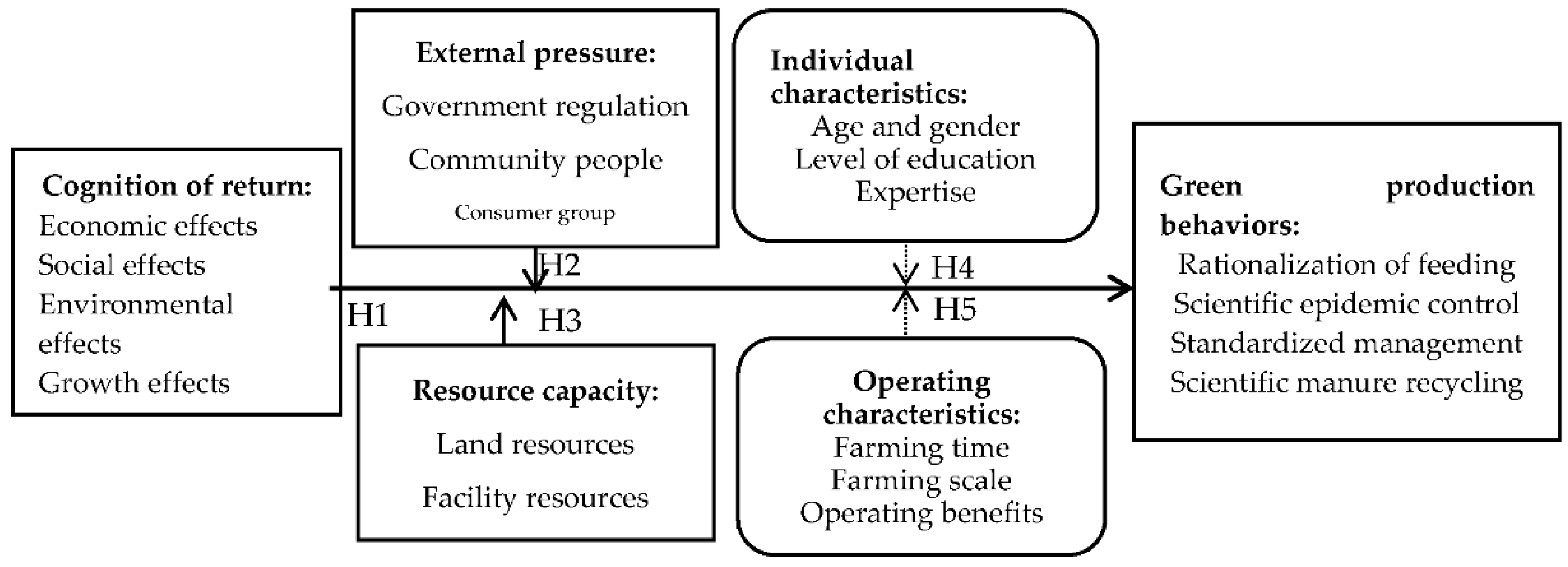
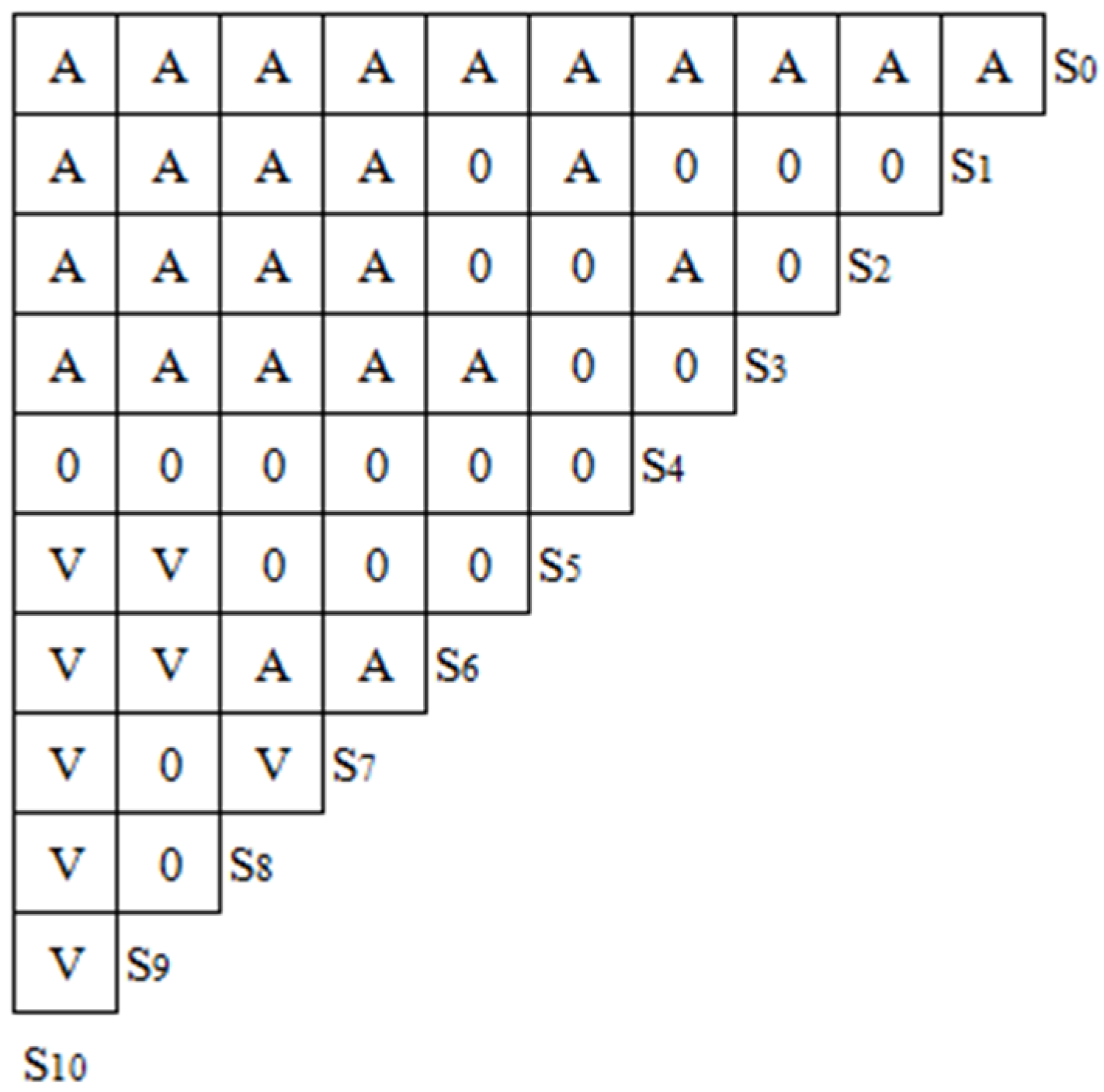
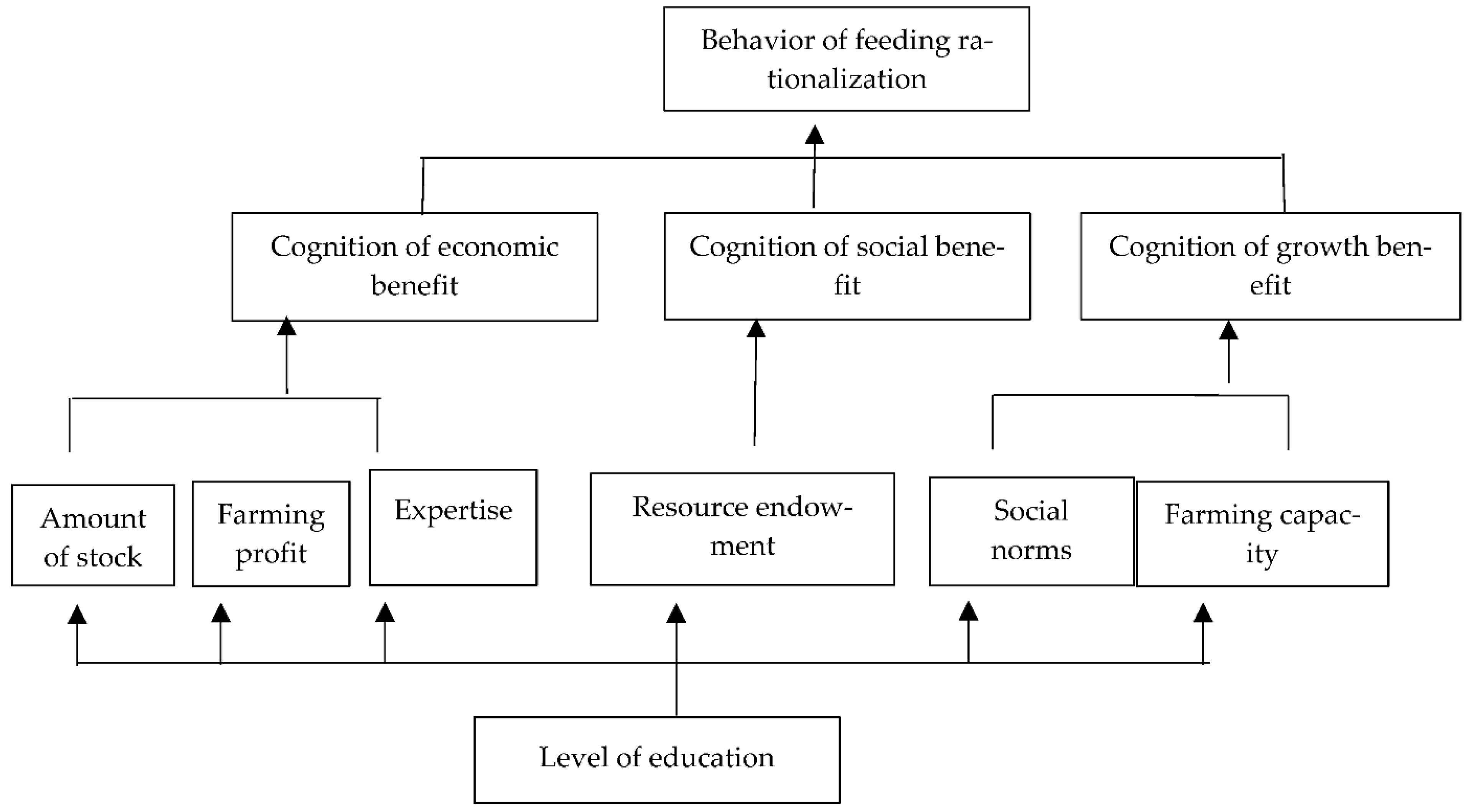

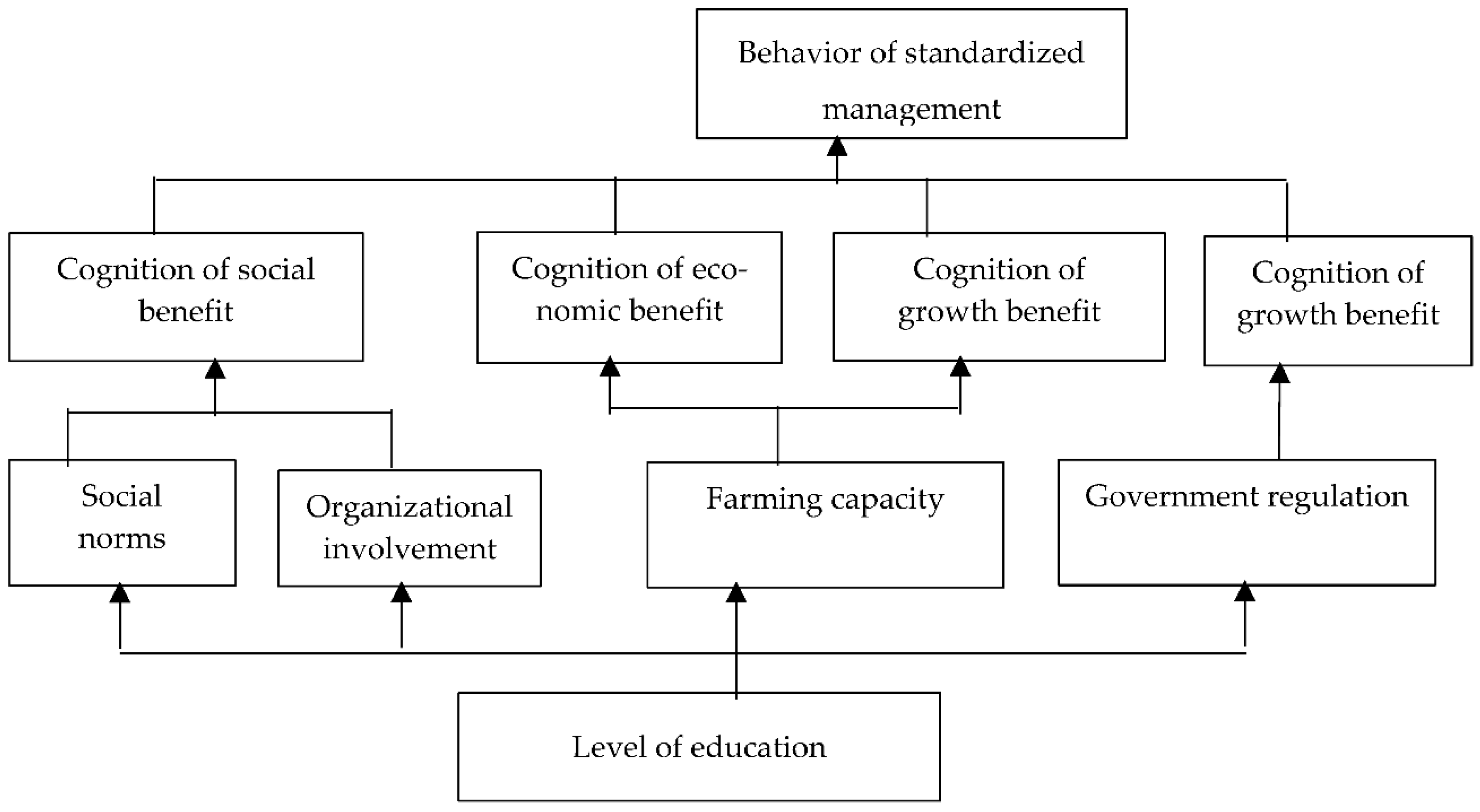
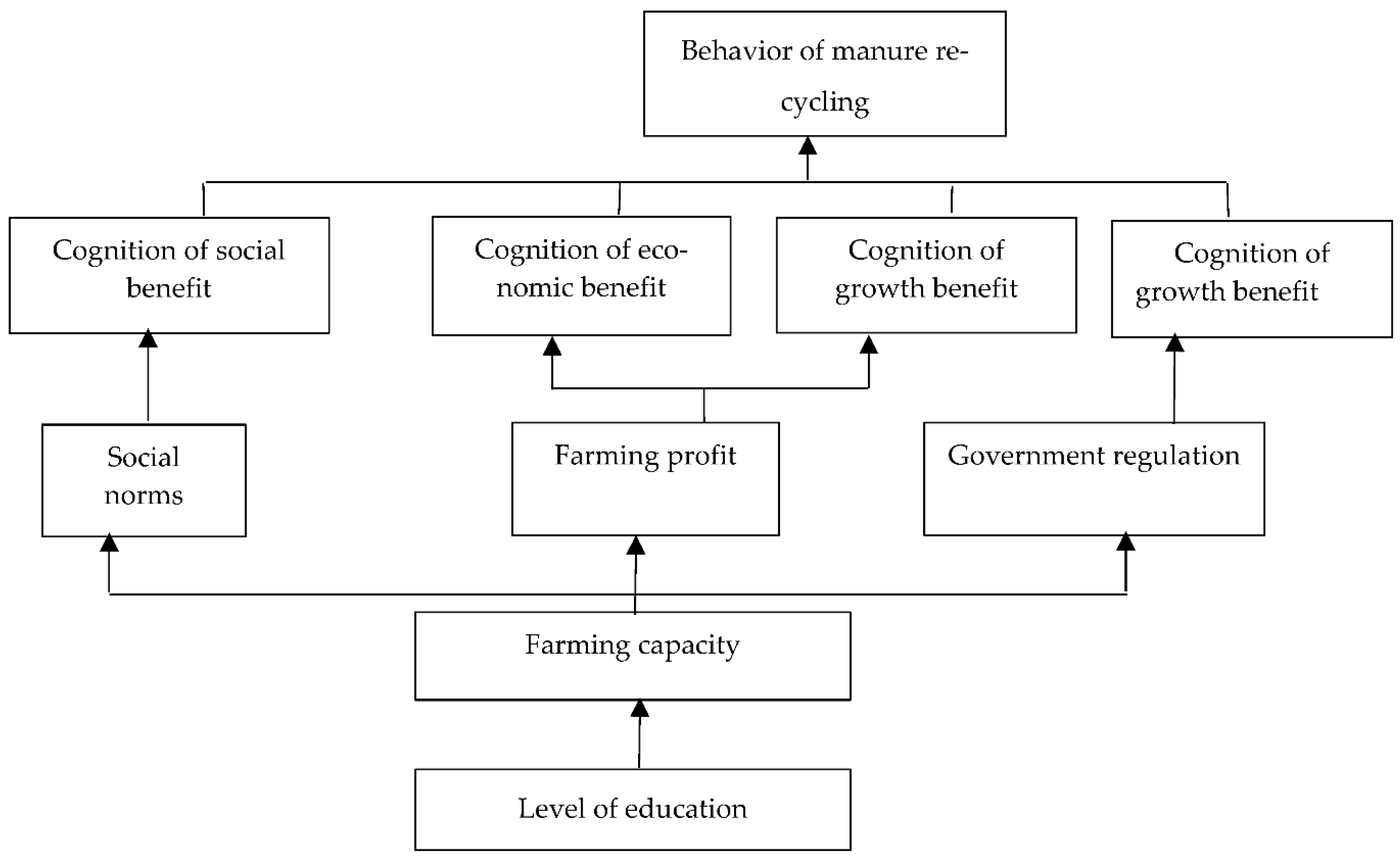
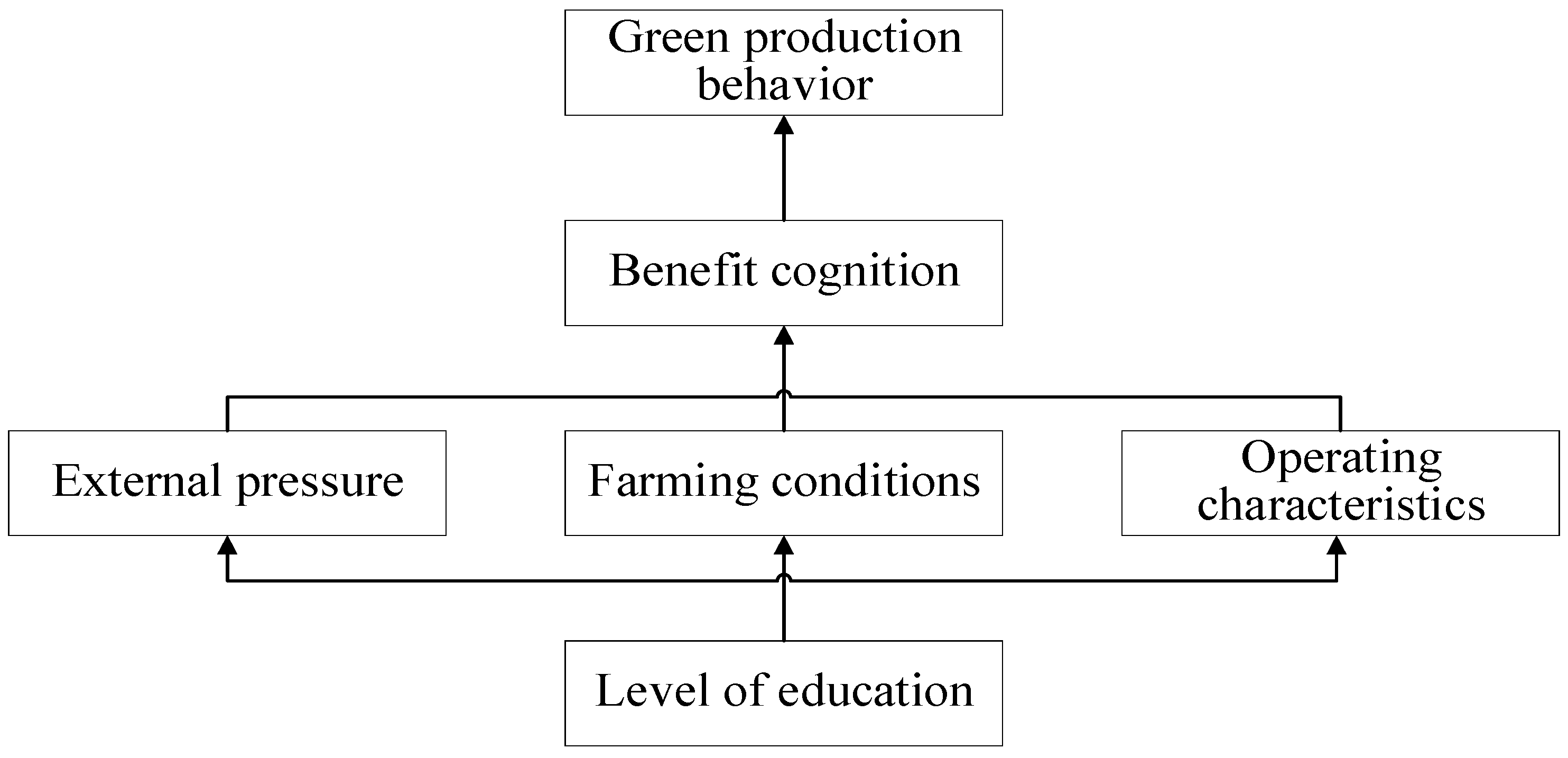
| Green Production Behaviors | Specific Performances |
|---|---|
| Rationalization of feeding | Use biological fermented feed; add drugs or additives allowed for use in the feed; adopt improved pig breeds. |
| Scientific epidemic control | Traditional Chinese Medicine or biological veterinary medicine is used for prevention or treatment; regulations on the drug withdrawal period are observed; sick and dead pigs are treated innocuously; pig houses and delivery vehicles are disinfected regularly. |
| Standardized management | The farms are standard or upgraded; farming files such as medication records are consistently kept; farms are frequently cleaned and sterilized. |
| Manure recycling | There are special manure storage facilities, biogas digesters, or manure treatment equipment; biological fermentation treatment technology is used; the manure is returned to the field. |
| Variables | Name | Definition | Assignment | Mean | Standard Deviation | Expected Impact |
|---|---|---|---|---|---|---|
| Explained variables | ||||||
| Green production behaviors | Rationalization of feeding | See Table 1 for details | 1 = at least one answer is yes; 0 = all answers are no. | 0.70 | 0.46 | |
| Scientific epidemic control | 0.70 | 0.46 | ||||
| Standardized management | 0.76 | 0.43 | ||||
| Manure recycling | 0.77 | 0.42 | ||||
| Explanatory variables | ||||||
| Cognition of return | Economic benefits | Green production behaviors can increase economic income; Green production behaviors can save farming costs. | Completely disagree = 1; Comparatively disagree = 2; Generally = 3; Comparatively agree = 4; Completely agree = 5 | 3.69 | 1.23 | + |
| Social benefits | Green production behaviors can improve product quality; Green production behaviors can improve product quality. | 3.67 | 1.20 | + | ||
| Environmental benefits | Green production behaviors can improve the quality of ecological environment; Green production behaviors can reduce pollution emissions. | 3.64 | 1.32 | + | ||
| Growth benefits | Green production behaviors can promote employee growth; Green production behaviors can regulate internal management | 3.66 | 1.28 | + | ||
| External pressure | Government regulation | The government has strict requirements for green farming | 3.62 | 1.14 | + | |
| Consumer demand | Consumers have the higher requirements for quality | 3.66 | 1.13 | + | ||
| Social norms | Social norms have strict supervision over green farming | 3.63 | 1.20 | + | ||
| Resource capacity | Resource endowment | Whether there is arable or forest land | 1 = Yes; 0 = No | 0.59 | 0.49 | + |
| Farming capacity | Automation technology applied (including feeding, drinking, cleaning manure, etc.) | Not applied = 1; One applied = 2; Two applied = 3; Three applied = 4; More than four applied = 5 | 3.59 | 1.28 | + | |
| Individual characteristics | Gender | Sex of farm owner | Male = 1; Female = 0 | 0.91 | 0.28 | + |
| Age | Age of farm owner | Actual age (years) | 49.34 | 8.92 | − | |
| Level of education | Level of education of farm owners | Primary school and below = 1; junior high school = 2; senior high school = 3; college and undergraduate = 4; graduate student and above = 5 | 1.97 | 1.06 | + | |
| Specialty | Owner has studied relevant specialties | 1 = Yes; 0 = No | 0.43 | 0.50 | + | |
| Operating characteristics | Farming time | Farming years of the farm | Actual farming period (years) | 12.9 | 6.56 | + |
| Breeding stock | Number of columns in the previous year | Year-end farm stock (PCS) | 102 | 137.9 | + | |
| Farming profit | Breeding stock of the previous year | Actual profit of the farm at the end of the year (ten thousand yuan) | 115 | 253.1 | + | |
| Characteristics | Classification | Overall | Individual Pig Farmers | Small-Sized | Medium-Sized | ||||
|---|---|---|---|---|---|---|---|---|---|
| Occurrence Number | Frequency% | Occurrence Number | frequency% | Occurrence Number | Frequency% | Occurrence Number | Frequency% | ||
| Gender | Male | 683 | 91.4 | 149 | 88.2 | 377 | 92.5 | 157 | 92.3 |
| Female | 64 | 8.6 | 20 | 11.8 | 31 | 7.5 | 13 | 7.7 | |
| Age | ≤30 years old | 9 | 1.2 | 1 | 0.6 | 5 | 1.2 | 3 | 1.8 |
| 30–39 years old | 87 | 11.6 | 19 | 11.2 | 49 | 12 | 19 | 11.2 | |
| 40–49 years old | 247 | 33.1 | 60 | 35.5 | 130 | 31.8 | 57 | 33.5 | |
| 50–59 years old | 315 | 42.2 | 67 | 39.6 | 176 | 43.1 | 72 | 42.4 | |
| ≥60 years old | 89 | 12 | 22 | 13 | 48 | 11.8 | 19 | 11.2 | |
| Level of education | Primary school and below | 88 | 11.6 | 16 | 9.4 | 58 | 14.2 | 14 | 8.2 |
| Junior high | 361 | 48.3 | 72 | 42.6 | 202 | 49.5 | 87 | 51.2 | |
| High school (technical secondary school) | 231 | 30.1 | 65 | 38.4 | 117 | 28.7 | 49 | 21.8 | |
| College and undergraduate | 67 | 9 | 16 | 9.4 | 31 | 7.6 | 20 | 11.8 | |
| Master degree and above | 0 | 0 | 0 | 0 | 0 | 0 | 0 | 0 | |
| Concurrent business degree | Full-time farming | 457 | 61.2 | 96 | 56.8 | 254 | 62.3 | 107 | 62.9 |
| Semi-farming | 253 | 33.9 | 60 | 35.5 | 135 | 33.1 | 58 | 34.1 | |
| Part-time farming | 37 | 4.9 | 13 | 7.7 | 19 | 4.7 | 5 | 2.9 | |
| Rationalization of Feeding | Scientific Epidemic Control | Standardized Management | Manure Recycling | ||||||
|---|---|---|---|---|---|---|---|---|---|
| Variable Classification | Name | Model 1 | Model 2 | Model 1 | Model 2 | Model 1 | Model 2 | Model 1 | Model 2 |
| Cognition of return | Cognition of economic benefits | 0.814 *** (0.000) | 0.865 *** (0.000) | 0.986 *** (0.001) | 0.865 *** (0.002) | 0.470 ** (0.011) | 0.447 *** (0.008) | 0.546 *** (0.003) | 0.584 *** (0.001) |
| Cognition of social benefits | 1.418 ** (0.000) | 1.207 *** (0.000) | 0.937 *** (0.008) | 0.895 *** (0.000) | 0.580 *** (0.004) | 0.503 *** (0.008) | 1.676 *** (0.000) | 1.609 *** (0.000) | |
| Cognition of environmental benefits | 0.245 (0.245) | —— | 0.519 * (0.086) | 0.482 * (0.089) | 0.447 ** (0.013) | 0.494 *** (0.003) | 0.769 *** (0.000) | 0.742 *** (0.000) | |
| Cognition of growth benefits | 0.851 *** (0.000) | 0.880 *** (0.000) | 1.039 *** (0.001) | 0.890 *** (0.001) | 0.535 *** (0.004) | 0.449 *** (0.008) | 0.496 *** (0.007) | 0.476 ** (0.013) | |
| External pressure | Government regulation | 0.083 (0.741) | —— | 1.706 *** (0.000) | 1.661 *** (0.000) | 0.503 ** (0.028) | 0.511 ** (0.012) | 0.470 * (0.070) | 0.455 * (0.050) |
| Consumer demand | 0.323 (0.181) | —— | 2.161 *** (0.000) | 2.145 *** (0.000) | 0.488 * (0.091) | 0.613 ** (0.018) | 0.022 (0.943) | —— | |
| Social norms | 1.205 *** (0.000) | 1.414 *** (0.000) | 0.831 ** (0.019) | 0.723 ** (0.034) | 0.985 *** (0.000) | 0.897 *** (0.000) | 0.878 *** (0.002) | 0.859 *** (0.002 | |
| Resource capacity | Resource endowment | 1.026 *** (0.001) | 1.041 *** (0.001) | 0.031 (0.994) | —— | 0.057 (0.869) | —— | 0.301 (0.404) | —— |
| Farming capacity | 0.351 ** (0.039) | 0.390 ** (0.024) | 0.659 * (0.056) | 0.630 * (0.050) | 0.555 *** (0.002) | 0.631 *** (0.000) | 0.313 * (0.082) | 0.239 * (0.089) | |
| Individual characteristics | Sex of owner | 0.110 (0.787) | —— | 0.527 (0.664) | —— | −0.312 (0.525) | —— | −0.164 (0.773) | —— |
| Age of the owner | 0.024 (0.222) | —— | 0.039 (0.333) | —— | −0.005 (0.840) | —— | 0.019 (0.421) | —— | |
| Level of education | 0.811 *** (0.000) | 0.866 *** (0.000) | 2.359 *** (0.000) | 1.875 *** (0.001) | 0.860 ** (0.044) | 1.292 *** (0.000) | 0.711 ** (0.016) | 0.448 ** (0.049) | |
| Expertise | 1.437 *** (0.000) | 1.390 *** (0.000) | 1.205 * (0.051) | —— | 0.149 (0.756) | —— | 0.644 (0.167) | —— | |
| Operating characteristics | Working time | −0.023 (0.293) | —— | 0.045 (0.324) | —— | 0.044 (0.110) | —— | 0.047 (0.118) | —— |
| Breeding stock | −0.004 *** (0.001) | −0.004 *** (0.002) | 0.054 *** (0.000) | 0.056 *** (0.000) | 0.022 (0.122) | —— | 0.001 (0.777) | —— | |
| Farming profit | 0.048 * (0.058) | 0.049 * (0.056) | 0.128 *** (0.000) | 0.128 *** (0.000) | 0.035 (0.802) | —— | 0.015 * (0.061) | 0.019 *** (0.001) | |
| Constant term | −7.235 *** (0.000) | −5.773 *** (0.000) | −24.84 *** (0.000) | −21.01 *** (0.000) | −9.409 *** (0.000) | −9.507 *** (0.000) | −11.22 *** (0.000) | −9.491 *** (0.000) | |
| Adjusted R2 | 0.589 | 0.581 | 0.863 | 0.859 | 0.692 | 0.664 | 0.695 | 0.683 | |
| Significance p-value | 0.000 | 0.000 | 0.000 | 0.000 | 0.000 | 0.000 | 0.000 | 0.000 | |
Disclaimer/Publisher’s Note: The statements, opinions and data contained in all publications are solely those of the individual author(s) and contributor(s) and not of MDPI and/or the editor(s). MDPI and/or the editor(s) disclaim responsibility for any injury to people or property resulting from any ideas, methods, instructions or products referred to in the content. |
© 2023 by the authors. Licensee MDPI, Basel, Switzerland. This article is an open access article distributed under the terms and conditions of the Creative Commons Attribution (CC BY) license (https://creativecommons.org/licenses/by/4.0/).
Share and Cite
He, Z.; Jia, Y.; Ji, Y. Analysis of Influencing Factors and Mechanism of Farmers’ Green Production Behaviors in China. Int. J. Environ. Res. Public Health 2023, 20, 961. https://doi.org/10.3390/ijerph20020961
He Z, Jia Y, Ji Y. Analysis of Influencing Factors and Mechanism of Farmers’ Green Production Behaviors in China. International Journal of Environmental Research and Public Health. 2023; 20(2):961. https://doi.org/10.3390/ijerph20020961
Chicago/Turabian StyleHe, Zejun, Yunfei Jia, and Yifan Ji. 2023. "Analysis of Influencing Factors and Mechanism of Farmers’ Green Production Behaviors in China" International Journal of Environmental Research and Public Health 20, no. 2: 961. https://doi.org/10.3390/ijerph20020961
APA StyleHe, Z., Jia, Y., & Ji, Y. (2023). Analysis of Influencing Factors and Mechanism of Farmers’ Green Production Behaviors in China. International Journal of Environmental Research and Public Health, 20(2), 961. https://doi.org/10.3390/ijerph20020961






